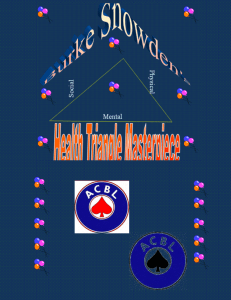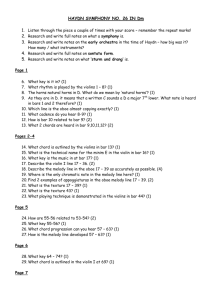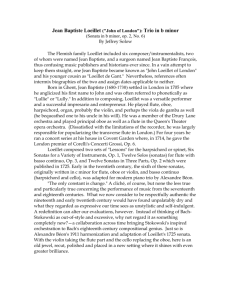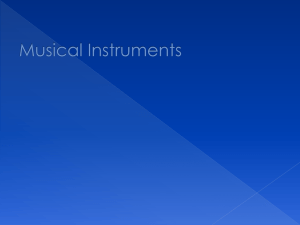MORE THAN MOZART A RESEARCH PAPER SUBMITTED TO THE GRADUATE SCHOOL
advertisement
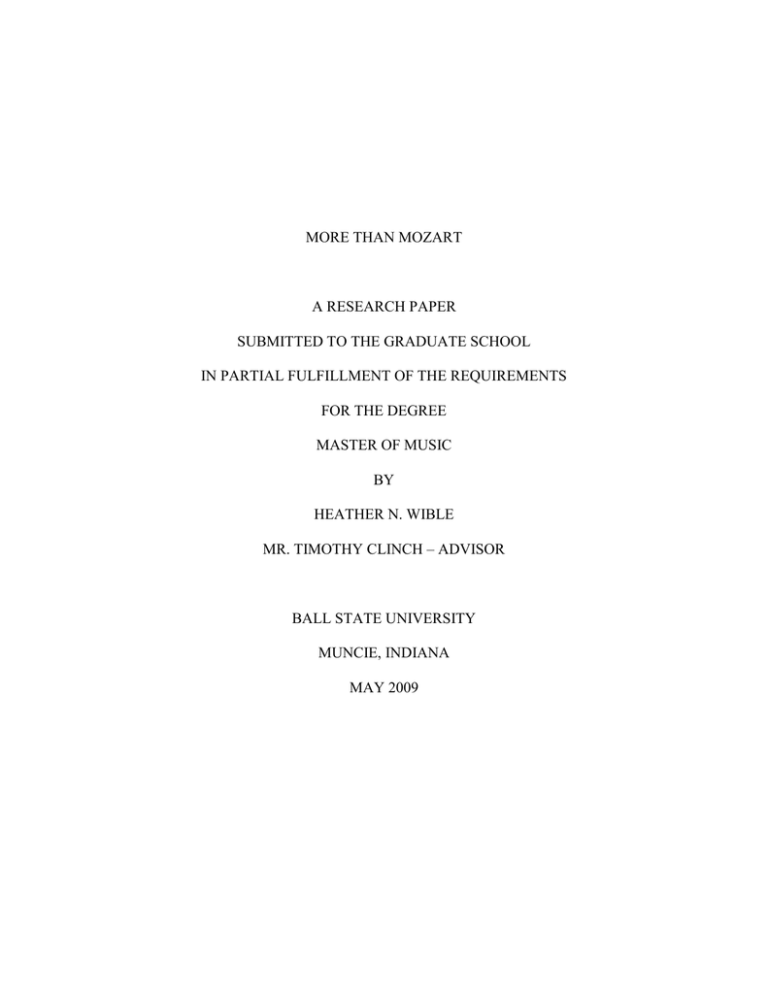
MORE THAN MOZART A RESEARCH PAPER SUBMITTED TO THE GRADUATE SCHOOL IN PARTIAL FULFILLMENT OF THE REQUIREMENTS FOR THE DEGREE MASTER OF MUSIC BY HEATHER N. WIBLE MR. TIMOTHY CLINCH – ADVISOR BALL STATE UNIVERSITY MUNCIE, INDIANA MAY 2009 Wible 1 Whether it is because of its difficulty or because of its unique sound, the oboe has never quite achieved the superstardom of the violin, the fireworks of the piano, the soul of the cello or the diva status of the voice. Many claim the oboe as a favorite, but few truly invest in it – mastering it, composing for it, or even listening to it. Consequently, little is known of what the oboe really has to offer. The extent of oboe repertoire knowledge tends to be “the duck” of Prokofiev‟s Peter and the Wolf for the average person, “the snake charmer” of exotic pieces like the Bacchanale from Samson and Delilah or Rimsky-Korsakov‟s Scheherazade for the classical enthusiast and of course, the Mozart Concerto in C for the truly knowledgeable.1 But the oboe is a complex creature, a formidable foe, and a satisfying sidekick. Poetic language aside, the truth of the matter is, when it comes to the oboe, there‟s more than Mozart. The oboe can play more than an A at 440 or a lugubrious, melancholic phrase over a thin string texture – though it does those well. It can take the concert stage by storm, but even of the pieces written for the oboe, many more should be played than actually are. Three have been chosen for a discussion here of the underestimated nature of the oboe and of these pieces: J.S. Bach‟s Concerto for Violin and Oboe, Ravel‟s Sonatine originally for piano solo arranged by David Walter for oboe and piano, and Pasculli‟s Fantasia sull’ opera ‘Poliuto’ di Donizetti. Each of the three has its challenges for the student performer to conquer, and its qualities for the audience to admire. It is important to understand a little of the long history of the oboe‟s development. The modern oboe as it is known today is not a relatively new instrument, but rather has come about through several centuries of change. Depictions have been discovered of 1 Also known as the audition committee. Wible 2 similar instruments, dating back to the time of antiquity. The most known of these is the aulos – a Greek double-bodied reed instrument considered important in theatre and an ancestor to the bagpipes. The earliest direct ancestor is the shawm – a conical, doublereed instrument most likely introduced to Europe during the time of the Crusades. The shawm was an outdoor instrument used by armies in war and dancing; the oboe was created by Jean Hotteterre as an indoor version and altered to accommodate the increasing chromaticism in music during the 1600‟s.2 All this to say, the oboe is no new kid on the block, but has a pedigree as strong as any flute, piano or violin. Part of the oboe‟s repertoire and reputation conundrum may be that attention to the structure of the oboe and improvement thereupon was really only begun in the second half of the nineteenth-century, by the Triébert family in France, and it is the French who seem to have most taken the oboe under their wing and paid the closest attention to its growth and development. Another traditionally defining characteristic, and speedbump on the oboe‟s road to popularity, is its tendency towards instability. With Hottetterre‟s indoor shawm, without a key system, it lacked an “even timbre” and possessed a somewhat “obscured sound.”3 Reeds of course have always posed a problem, being an organic product and subject to changes in barometric pressure, temperature, weather, time and the will of God, or so it seems from time to time. Nevertheless, the oboe and its faithful fans have pressed on through time to continue improving it. The composer Jean Baptiste Lully (1632-1687) took a liking to the oboe and began including it in his scores and opera pits, thus opening it to a wider 2 Elizabeth McKeown Pevey, “Oboe History,” found on Covey Oboes website. http://www.oboes.com/oboehistory.html#timeline 3 ibid. Wible 3 audience than the royal courts, where it had mostly been confined. Oboists were also paid more highly if they were willing to travel, thus the continual spreading of the instrument by means of troubadours throughout Europe. Johann Sebastian Bach was born two years before Lully‟s death, and therefore emerged with a knowledge of the oboe and its by then standard presence in an orchestra. Many of the oboe‟s most beautiful works come from the pen of J.S. Bach – the “Adagio” from the Easter Oratorio, major roles in several cantatas, etc. But most of these are in the context of the orchestra, few put the oboe out front of the orchestra to be admired. Other members of the oboe family also received attention, concerti, even. At least two concerti for oboe d‟amore have been reconstructed: A Major and D Major. There is, however, the Concerto in C Minor for Violin and Oboe, BWV 1060. The original manuscript to this piece no longer exists, but it does exist in form for two harpsichords. Nonetheless, it has been widely accepted, that the piece was originally written for violin and oboe. It was not uncommon for Bach to reuse his own works in later pieces or in different combinations. A publisher‟s catalogue from 1764 lists a concerto by Bach for violin and oboe, but does not list a key. The tessitura and other musical characteristics of the piece suggest that it was originally for oboe and violin.4 The lack of an original manuscript clearly puts performers and academics alike at a serious disadvantage, but what exists as a reconstruction, is very plausible and playable, though not without its difficulties. There are a few key differences between the oboe of Bach‟s time and today‟s oboe, which change this piece from being an amateur-friendly 4 James. M. Keller, “Concerto in D minor for Oboe, Violin, and Strings, BWV 1060,” originally printed in San Francisco Symphony program books, reprinted in New York Philharmonic program notes with permission, http://nyphil.org/programNotes/0405_Bach_ArtofFugue_ConcertoBWV1060.pdf. Wible 4 piece to being demanding of even the best professionals. The Baroque oboe uses a wider, lighter reed that responds more readily and requires less air to control. The sound, however, does not carry through a large orchestra, which is why modern oboes today use a heavier reed, as the size of the orchestra has changed dramatically since Bach‟s time. Because of this lighter reed, oboists of the time could articulate for days and play nearly an entire movement on one breath.5 Today, oboists cannot play for nearly as long on one breath, nor articulate every note as easily. On the other hand the modern oboe and its construction can obtain a more dignified and graceful tone than could its ancestor. In the reconstructed parts, there are few to no printed articulations. Part of this can be attributed to the missing original, and part can be attributed to the Baroque oboe‟s ability to tongue every note with ease. Consequently, every modern interpretation of the piece will be different, from player to player – each having their own articulation meticulously thought out, paying attention to phrasing, musical intent and collaboration with the violinist and his bowings. These personal decisions as to articulation, phrasing and note grouping were allowed and even expected during the Baroque period and is a process important for a musician to go through, to develop individual style and independent thought. In the entire work, which is three movements, there is no point at which the oboist rests for more than three measures at a time. This may be well and good for a Baroque oboist, but for a modern oboist, this is quite the challenge. Endurance is the hardest thing about this piece. The phrasing can lend itself to a breath here and there, and this is frequently the saving grace. More oft than not, Bach‟s tendency to spin new phrases out 5 This, of course, is a slight exaggeration. Wible 5 of the endings of old phrases causes more than a few faces to turn varying shades of purple. There are a few places in the third movement where echoing notes can be left for the violin to play alone, but the majority of the piece must be conquered by old-fashioned expansion of lung capacity or new-fangled circular breathing. The movements individually present obstacles as well. Aside from the endurance factor, the first movement, marked “Allegro,” forces the performers to choose whether to phrase the theme in two or in four. The way it is written, the natural tendency is to phrase in four, but the accompaniment encourages a feeling of two. In order to maintain continual forward motion, a feeling of two is also encouraged. Identifying and maintaining tempo and forward motion, as well as lush but light tone are the tasks in the second movement, marked “Adagio.” Written in 12/8 time, again the performer must choose whether it has a feeling of 12 or of 4. The chosen tempo and feel will indicate the emotional overtones of the movement. The phrases are long and gorgeous, but staying in 12 can make the movement seem to last for ages and its enchantment becomes lost on the audience. In the orchestration, the strings are marked pizzicato, also lending to the argument of beautiful but light. To maintain a slow tempo with a heavy tone would be very much like Godzilla trying to do ballet – inappropriate and painful. Although the overall piece is keyed in the minor, it is not yet coming from a time period where minor means sad, necessarily. It more means emotionally poignant. The movement is filled with tenderness, musically accomplished in hidden cadences and a marvelous deceptive cadence in the last half of the piece. Each one of these cadential points should be special moments acknowledged by the performers in such a way that the Wible 6 audience is made aware, but not beaten over the head. This delicacy must still have strength, else it lose its credibility. The third movement is quite the contrast to the second movement. It is marked “Allegro” like the first, but has a more aggressive, edgy feel than the first. And yet the tempo cannot go too quickly – the violinist and accompanist will panic or refuse. In addition, rather than being refreshed, the audience (and performer) will be exhausted. The motto of this movement is “self-control,” and again, endurance is key. Although the piece is short from the audience‟s standpoint, it seems much longer from the performer‟s. The previous two movements have demanded much, and to follow with the energy necessary to truly pull off the last movement is nothing at which to sneeze. Each movement has its charm, and each movement has its challenge, but all movements show the oboe as equal and capable enough to share the stage with any violinist. It should be performed more often. The differing qualities of the two instruments provide endless combinations and variations to keep both audience and performers interested. For all the interest and care the French have shown in the oboe, it would seem that French music would be simple for the instrument, but indeed it is not. Although the French have been kind to the oboe in its advancement, few have written much solo repertoire for the instrument, though they have written the bulk of it, and have written a great deal within the context of the orchestra. Ravel, for example, has shown an affinity for the instrument in his adaptation of his piano piece Le Tombeau de Couperin for the orchestra, giving the oboe a very prominent role – such that it seems almost an oboe concerto from the middle of the orchestra rather than in front of it. The current oboe Wible 7 professor for the Paris Conservatoire (David Walter) has taken a page or two from Ravel‟s book and made an arrangement of Ravel‟s Sonatine, originally for piano solo, for oboe and piano. Although some pianists may scoff at this idea and consider it blasphemous, it would be good to remind them that Ravel himself would do the very same thing, to his own music and to the music of others. Generally Ravel would orchestrate them for a larger ensemble, but there is no reason to think he would not approve, especially when Walter has done as careful and beautiful a job as he has done in the Sonatine. The Sonatine itself is masterfully written. Produced during Ravel‟s most prolific and fruitful years of writing, it reflects a love of Mozart and classicism with its very clear sonata forms, but it also has a certain panache which only Ravel can achieve.6 Beginning with the theme of the first movement, each movement is related to the others with appearances and transformations of themes from one section to the next.7 It flows together seamlessly.8 Walter‟s arrangement thoughtfully maintains all of the work‟s charm, while exploiting the oboe‟s melancholic tone. Everything the oboe (but not always the performer) does so well – long lines, understated expression, subtlety, a certain bit of flair – can be found in this piece. Along with most things it does not do so well naturally (but it capable of in the right hands) – notes in the upper stratosphere of the oboe‟s range, notes in the depths of the oboe‟s range, clarity of tone with depth – can also be found in this piece. 6 Rollo Myers, Ravel: Life & Works, (New York: Thomas Yousseff, 1960), 34. Vlado Perlemuter and Hélène Jourdan-Morhange, Ravel According to Ravel, trans. Frances Tanner, ed. Harold Taylor, (White Plains: Pro/AM Music Resources, Inc., 1970), 11. 8 See Appendix for musical examples. 7 Wible 8 In no way is this merely an oboe piece with a simple accompaniment, either. Walter has kept all the motion found in the original piano score, and simply removed the melody from the piano and given it to the oboe. The two instruments are absolutely intertwined and dependent on each other. It is truly a collaborative piece, and so rewarding for it. Some pianists have said the accompaniment is more difficult to play once the original has been learned, because they then have to keep themselves from playing the melody, which helps the rest of the fingers know where to go. The piece does not play itself. The notes are for the most part simple enough, and although the piece is beautiful, it requires intelligence and gentility on the part of the performers to really give it its sparkle. Without such, it is rather like a lovely patch of grass with great potential, but waiting for someone to come along and plant some flowers. Endurance is not a problem, per se, but flexibility is. There are plenty of rests in the piece, but the range of notes the oboist must cover – from nearly the lowest note possible (low B) to nearly the highest note possible (double high A) – make it a rather gymnastic exercise. If one is not flexible, and does not have a reed perfectly balanced (light enough to play the lows with little argument and big enough to pop out the highest notes without being sharp or subtoned), then one is liable to be very tired by the end of it. The rhythms are simple, but must be precise, because of the interlocking of the piano and oboe parts.9 There are a great number of tempo changes, in the piece, however -- a good test of chamber music skills. Again communication is essential between the oboist and pianist. Many of the tempo changes are not necessarily metronomic either, but 9 And precise rhythm is just part of good music, though some pieces are more forgiving than others. Wible 9 are mood changes. It takes a great deal of musical maturity to understand and achieve these marked (and unmarked) effects. Arguably the hardest part of understanding the piece, however, is mastering the typical transparent depth of Ravel‟s music. The music must be like a very clear, pure pond. Where one can look down through the water all the way to the bottom, such that it seems very shallow, but as one enters the water it is much deeper than originally thought. To say this is one thing, to say this with an oboe and a squirrelly piece of cane is something else entirely. The essence of the task is to choose very precisely which overtones should shine forth, and which should be withheld. Again the balance of the reed is important, also the formation of a good French vowel embouchure will help, and a few mental tricks may just get the task done … the next step is to keep a level enough head on stage that all those will work. The first two movements most exhibit these aforementioned traits and challenges, and are the most similar to each other. The third movement is a bit different from the first two, although, as previously mentioned, it is still thematically linked to the others. The third movement makes use of a horn call motive, a figure with which, being not a horn, the oboe is not well practiced. The mood of the third movement is more aggressive than contemplative or reflective. It is more like some stone has been thrown into the pond, and its glassy surface has been upset. This movement, like the first, reaches up to the oboe‟s very highest notes. They are only suggested, and there is an option for them to be played an octave lower -- a lovely alternative for those who do not prefer to take any more risks on stage than necessary, or for a younger student who is learning to play in the French style. Nevertheless, it makes for quite an effect, if the upper notes can be tamed Wible 10 enough to speak properly, and still wild enough to produce the dramatic effect, for which they are written. Additionally choosing the upper octave serves to continue the previous line, rather than break it up by dropping down the octave. That said, the piece does not really lose anything by choosing the safer, standard option; it stands to gain so much more by committing to the upper notes.10 It is fitting that it was a French opera composer (Lully) who served to give the oboe it‟s orchestral debut, since the oboe world owes so much to both the French and the opera. The oboe has been treated very handsomely in opera scores, accompanying some very lovely arias.11 Yet opera with a healthy dose of Liszt, has also served as the inspiration for some of the only truly showcase pieces the oboe can claim. During the second half of the 19th there was a virtuosic oboist named Antonio Pasculli. Indeed he is frequently equated with Paganini, such was his talent. Like Paganini, Pasculli could not find music that adequately displayed his grand talent.12 Since necessity is the mother of invention, Pasculli decided to produce the pieces to show the world what he could do with an oboe.13 Consequently it is now possible (though not often undertaken) to display the grand technical capacity of the instrument. In the 10 In the original piano score, of course the upper notes are a natural and even easier option for the pianist, whose fingers are already up in that area of the keyboard. It shows attention on Walter‟s part that he leaves them as an option, while marking the more common notes as the standard. 11 Aida comes to mind. 12 Laura and Concetta Pasculli, interviewed by Lucienne Rosset, “Antonio Pasculli, the „Paganini of the Oboe,‟ trans. Ellen Ferry, http://www.idrs.org/publications/DR/DR10.3/DR10.3.Rosset.html 13 Pasculli‟s influence and work extended far beyond the world of the oboe as well. He lived in Palermo, Italy and in 1917 became director of the municipal musical Corps. In this position he raised the level of playing in the ensembles, even teaching the wind players how to play string instruments. With this „new‟ ensemble, music of his nonItalian contemporaries (Wagner, Sibelius, Debussy) was played, which had previously been seldom heard. Wible 11 manner of Liszt, Pasculli chose several lyric operas and composed fantasias on themes from the operas – each getting its own showcase piece. The most commonly played today is the fantasia on La Favorita by Donizetti. La Favorita has a sister fantasy, which is not played as often but is equally stunning: Il Poliuto. Il Poliuto was composed by Donizetti for the opera in Naples, specifically with the famous tenor Adolphe Nourrit in mind. The opera was not performed, however, because the Italians “[frowned] on the representation of a saint‟s life on the operatic stage.”14 Donizetti did not give up on the opera, however, and upon later moving to France, transformed the opera from a three-act Italian opera, to a four-act French opera called Les Martyrs. In Pasculli‟s fantasia, the opera has again gone through a transformation of a different sort. Themes from the opera have been taken and very loosely been used to create variations, some of heart-wrenching emotion, some of head-spinning technique. The finger work involved in performing the Poliuto fantasia is intense, and has caused more than a few oboists to develop tendonitis from the practicing. When first glancing at the music, the first two pages seem manageable; there are a few tricky licks but for the most part it is oboe ad libitum. Then the page is turned and one is greeted with two pages of solid black ink – straight sixty-fourth notes with no rests. Pasculli himself, had the fingers to accomplish the incredible effect, and could circular breathe, a fact not lost on the audience, as the notes would just roll out of the oboe ceaselessly. Luckily it is not of the utmost importance that all the notes on the two pages are played; a few can be strategically left out for breaths, etc. When done correctly, the effect is outstanding. The 14 William Ashbrook, Donizetti, (London: Cassell & Company Ltd., 1965), 218. Wible 12 audience sees only one oboist on stage, but is hearing two! One is playing the uppermost notes (the melody) while the other seems to be playing continual scalar passages. If those two pages were all that the piece consisted of, it would still be mighty to behold, and yet there are six more pages of themes and variations. All in all the piece is split into ten sections – some slow, some fast. The sixty-fourth note pages are not the only pages to be wary of; it seems every other page has a technical variation, containing octave leaps, constant sixteenths, or endless phrases. Still, if the technique were all, it would be difficult, but manageable. It is for the flashy fingers that one chooses to perform this piece – very few really get to hear the oboe at its highest level of technical capacity (for better or for worse). Unfortunately in all the practicing of scales, the melodic sections tend to get neglected – and this is what the oboe is known for! The melodic themes must be cared for just as much as the flying figures, for they soar in their own way, tender, emotional, deep and dark. When the two are perfectly balanced, with a chuckle, the audience gets a true taste of the oboe‟s vast abilities – and the performer‟s honed skill. For all its history and all its potential, it seems the oboe can frequently be seen as the underdog instrument – capable only of brooding melodies … or the Mozart Concerto in C. One would think that given the limited repertoire it has, compared to the violin or the piano, that all the oboe‟s pieces would get equal playing time, but such is not the case. Hopefully the three discussed here will see their days of glory soon, and audiences and performers alike will be enriched for the inclusion. Wible 13 Appendix Selected examples of thematic relationships between movements in Ravel‟s Sonatine. Note: All examples are from the solo oboe part. Example 1 I. mm. 1-3 This is the opening theme in the first three measures of the first movement. Notice the rhythm and intervallic content: descending fourth, descending second, ascending series of seconds. Example 2 II. mm. 39-57 From the middle of the second measure. Again notice the rhythm and intervallic content: eighth note, quarter note, two sixteenths, eighth, two sixteenths; descending fourth, descending third, ascending second, ascending second. (Italics denote departure from original.) Wible 14 Also notice the use of the opening interval (descending fourth) as a transition theme. Bar 53 begins a repetition of the second movement‟s opening bars with one minor change in rhythm (the rest in bar 54 is not in the original statement). In a sense Ravel uses this as a pivot point, melodically. Example 3 III. mm. 37-40 From the middle of the third movement. The rhythm is not precisely the same as Example 1, but similar, almost proportional. The intervallic content is the same. Example 4 III. mm. 95-98 Another occurrence during the third movement similar to Example 1. Again observe the intervals and contour. This example opens with a descending fifth instead of a fourth. Example 5 III. measure 143 Again similar to Example 1, this time with the opening fourth returned. Wible 15 Example 6 III. mm. 154-158 Another example of the use of the pivot interval at bar 156. Also bars 157 and 158 are similar to Example 2, the variation in the second movement on the theme from the first movement. Wible 16 Bibliography Ashbrook, William. Donizetti. London: Cassell & Company, Ltd., 1965. Bach, Johann Sebastian. Konzert c-Moll für Oboe, Violine, Streicher und Basso continuo (Concerto in C Major for Oboe, Violin, Strings and Basso continuo). Rekonstruiert nach (Reconstructed from) BWV 1060. Kassel: Bärenreiter, 1972. Keller, James M. “Concerto in D Minor for Oboe, Violin and Strings.” Originally printed in San Francisco Symphony program book. http://nyphil.org/programNotes/0405_Bach_ArtofFugue_ConcertoBWV1060.pdf. Myers, Rollo H. Ravel: Life & Works. New York: Thomas Yoseloff, 1960. Pasculli, Antonio. Fantasia sull’opera ‘Poliuto’ di Donizetti. Edited by Omar Zoboli. Monteux: Musica Rara, 1989. Pasculli, Laura and Concetta. “Antonio Pasculli, the „Paganini of the Oboe.‟” By Lucienne Rosset. Translated by Ellen Ferry. http://www.idrs.org/publications/DR/DR10.3/DR10.3.Rosset.html Perlemuter, Vlado and Hélène Jourdan-Morhange. “Ravel According to Ravel.” Translated by Frances Tanner. Edited by Harold Taylor. White Plains: Pro/Am Music Resources, Inc., 1970. Ravel, Maurice. Sonatine pour piano. Transcribed for Oboe and Piano by David Walter. Paris: Éditions Durand, 1992.
